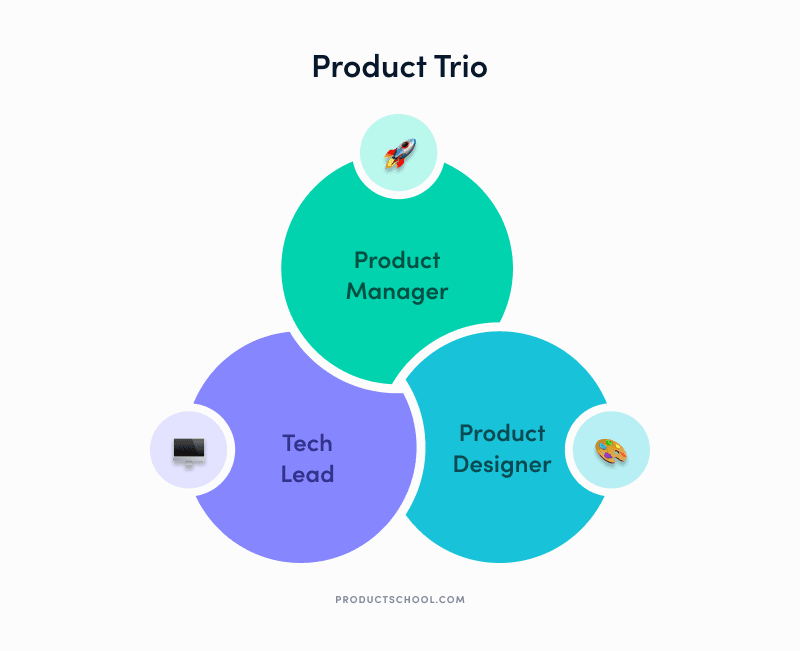Updated: July 2, 2025- 17 min read
Establishing an effective product team structure is an essential step for all successful product teams. With so many roles to join together — like Product Owners, Scrum Masters, Product Leaders, and Product Managers — figuring out where everyone fits is no small task.
Add to that the constantly shifting lines of authority, and it’s no wonder structuring a product team can be a headache. Here's the kicker though: product thinking doesn’t stop with just the product team. It spans across the entire company. To make the team work smoothly, as product leaders, you need support and buy-in from other departments, too. This is where highly functional product management organization comes in.
In this article, we’ll explore different ways to structure your product team, the benefits and possible pitfalls of each approach to organizing your product team, and some practical tips to make it all click.
What Is a Product Team and What Does It Encompass?
A product team is a group of people focused on building and improving products that meet users' needs and drive business growth. Each of these roles is pivotal to reaching team goals.
Effective product team organization brings together diverse skill sets like product management, product design, engineering, product analytics, and sometimes even marketing and sales. Each role has its own responsibility, but they all share one common goal: delivering a valuable product to users. Sound product management organization establishes the parameters for each role and keeps cross-functional teams efficient.
A typical product team includes roles like Product Managers, who drive product strategy, build roadmaps, and prioritize features. There are also Product Designers, who ensure user-friendly design; and Engineers who handle the technical build. You might also have a Product Owner or Product Specialist in an agile setup, who helps to manage backlogs and ensure the team stays on track. Data Analysts may also be in the mix to turn insights into action, Project Managers and Program Managers who are often confused with Product Managers, and UX researchers to deeply understand user behavior. Product evangelists are there to support the product team by advocate for the product within the company and creating a community of passionate users.
The product team doesn’t work in a bubble; rather, they need to collaborate closely with departments like marketing, customer support, and even sales to make sure their product aligns with broader goals.
This cross-functional approach is essential to gaining support and buy-in, as the best products are built when teams bridge the complexity gap. So, a product team isn’t just about product roles — it’s a dynamic unit that requires clear alignment, fluid communication, and a shared focus on solving real user problems. This is precisely why clear product team organization is intrinsically linked with teams that succeed.
What Is a Product Team Structure?
Product team structure doesn't just referring to a set org chart or predefined roles; it’s about aligning people, processes, and responsibilities in a way that gets the most out of every team member. The structure you choose should fit the product's lifecycle, company culture, and even the complexity of the product mix itself. It should also fit the type of team, whether it's a team focused on growth, platform, or other aspects of the business.
One key aspect of product team structure is understanding how to balance specialization and collaboration. For example, you might have a squad model, where cross-functional teams focus on specific product areas, giving them the freedom to iterate fast and deliver focused outcomes.
Otherwise, you may lean toward a triad structure, with clear partnerships between the product trio: the product manager, product designer, and the tech lead (or engineers). This ensures no strategic decisions are made without taking every perspective into account.

Then there’s the question of centralization versus decentralization. A centralized structure often allows for better alignment and consistency across teams with clear, top-down strategies. On the flip side, a decentralized structure offers more autonomy; it empowers product teams to adapt quickly to user needs and market changes.
But here's the reality: no structure is one-size-fits-all.
As the product evolves, so should your product management organization structure. Product management leadership often needs to recognize when a team’s setup is limiting creativity or slowing down execution. You might need to break down silos, redefine roles, or even create hybrid structures to improve collaboration across teams.
The true measure of an effective product team structure isn’t just in how well roles are defined, but in how smoothly the team moves from strategy to execution. An important part of this will be avoiding getting bogged down by hierarchy or decision-making bottlenecks. A strong product team structure is flexible, adaptable, and, above all, designed to deliver results regardless of how well it plays by the book!
10 Ways to Organize Product Management Team Structure
I believe in building missionary teams by aligning people towards the mission and the customer. And when you build such teams, these teams are willing to walk through walls, go to the ends of the earth to solve for product and they're not working for promotion money or anything. They're actually working for that impact.
— Prashanthi Ravanavarapu, Global Fintech Product Executive at PayPal, on The Product Podcast
1. The Squad Model
The squad model, also called the Spotify model, is made up of small, cross-functional teams that focus on a specific product area or feature. Each squad works independently, with all necessary roles (PM, designers, engineers, etc.) to deliver end-to-end solutions. This approach was popularized by Spotify.
The squad sets its own goals, manages its own product backlog, and follows Agile practices to deliver end-to-end solutions. Squads are empowered to make decisions quickly without waiting for external approvals.
The Squad Model is ideal for companies that need to move quickly and focus on rapid iterations, such as startups or Agile organizations.
Pros:
Autonomy allows for faster decision-making.
Strong ownership over specific product areas.
A clear focus on a well-defined goal or feature.
Cons:
Can create silos if squads don’t communicate effectively.
Risk of inconsistent design or tech standards across squads.
2. Triad Product Management Organization Structure
This structure emphasizes the collaboration of three core roles — Product Manager, Designer, and Engineering Lead — working closely together. Each “triad” tackles product decisions and problem-solving together.
This structure isn’t just about having three roles on paper; it’s about integrating their insights into every step of product development. The triad meets regularly, making joint decisions about the product vision, prioritization, and problem-solving. It’s designed to ensure that strategic decisions are well-balanced across product, design, and engineering, reducing gaps between planning and execution.
The Triad Structure is best for mid-to-large companies looking to align strategic decisions with design and technical feasibility early in the process.
Pros:
Balanced decision-making across disciplines.
Encourages faster validation of ideas.
Helps avoid misalignment between strategy, design, and tech.
Cons:
Depends heavily on strong relationships and communication.
Can slow down if there are conflicts between the triad members.
3. Feature-Based Teams
These teams are organized around specific product features or functions. Each team has a mix of roles needed to develop and maintain the feature throughout the product lifecycle.
This way of structuring is ideal for products with clearly defined features or modules, like software with multiple user-facing tools.
Pros:
A clear focus on specific product aspects.
Easier to prioritize and allocate resources.
Greater accountability and specialization.
Cons:
Risk of tunnel vision, focusing too narrowly on one feature.
Can create dependencies across teams, slowing progress.
4. Product Line Teams
Here, teams are structured based on different product lines within the company. Each team owns the product strategy, design, and development of a specific product line.
In this model, each team functions like a mini-business unit within the larger organization, managing all aspects of its product’s lifecycle—from ideation and development to launch and scaling. This structure allows the team to dive deep into the needs, challenges, and opportunities specific to their product, making it easier to drive tailored improvements and innovations.
It’s best for companies with rich product portfolios or multiple distinct services, like multi-product SaaS companies.
Pros:
Deep specialization in specific product lines.
Easier to manage multiple products at scale.
Better alignment between product teams and broader company goals.
Cons:
Limited flexibility to shift resources across product lines.
Can lead to competition for resources and priorities.
5. Stream-Aligned Teams
Teams are aligned to the flow of work, such as customer journeys or key business objectives. They manage end-to-end delivery, ensuring seamless handoffs and quick responses to customer needs.
Each team is cross-functional and includes all the necessary roles — Product Managers, Designers, Engineers, QA specialists, and sometimes Customer Support or Marketing — to support the entire process. The goal is to make sure that each step in the user flow is optimized and integrated so that the product experience feels seamless and well-connected.
Steam-aligned teams work well in complex organizations where speed and efficiency in responding to user needs are critical.
Pros:
Focuses on continuous value delivery.
Strong alignment with business outcomes.
Reduces handoffs and delays.
Cons:
Can be hard to maintain consistency across streams.
Requires frequent re-alignment to changing priorities.
6. Pod Structure
Pods are similar to squads but typically smaller and even more autonomous, each with its own roadmap and backlog. Pods often include roles beyond core product functions, such as marketing or customer success, to create a more holistic focus.
Pod structure is effective in scaling startups or companies that need nimble, versatile teams to deliver results quickly.
Pros:
Highly adaptable and self-sufficient.
Strong ownership of outcomes.
Better cross-functional collaboration beyond core product roles.
Cons:
Can result in competing priorities between pods.
Less consistency across the product as pods may approach things differently.
7. Matrix Structure
This structure blends functional and project-based reporting lines, meaning team members have dual reporting — one to the product team and one to their functional area (e.g., design, engineering).
For example, a designer on a product team would report both to the Product Manager and the Design Lead. This setup is intended to leverage specialized skills across multiple projects while ensuring alignment with overall product goals.
Team members split their time between working on their assigned product team and collaborating with colleagues in their functional area. This way, they contribute to product development while maintaining a consistent skill set and standards within their discipline.
Matrix structure is common in larger organizations where specialized skills are needed across multiple teams, like enterprise companies.
Pros:
Encourages knowledge sharing and specialization.
Allows for flexible resource allocation.
Balances product focus with functional expertise.
Cons:
Can be confusing for team members due to dual reporting.
May slow down decision-making if not managed well.
8. Centralized Product Team
Here, all product roles report to one centralized product management team, which sets strategy, priorities, and best practices.
In this setup, the product management team acts as the strategic hub — they create consistent product vision and ensure that every product decision aligns with broader business objectives. The centralized team also handles resource allocation, oversees major projects, and enforces standard product frameworks and methodologies.
A centralized approach works best in early-stage startups or companies prioritizing consistent product strategy and execution.
Pros:
Strong alignment and strategic consistency.
Easier to enforce standard practices.
Centralized decision-making simplifies prioritization.
Cons:
Can lack flexibility and responsiveness to specific needs.
May slow down innovation due to hierarchy.
9. Decentralized Product Team
In this setup, product roles are spread across different departments or business units, each with its own product management team that drives local strategies.
It’s great for large enterprises with diverse product mixes or market segments.
Pros:
High autonomy and adaptability.
Teams can quickly respond to local customer needs.
Encourages innovation through independent decision-making.
Cons:
Harder to maintain a unified product vision.
Can result in duplicated efforts and inconsistent standards.
10. Full-Stack Teams
These teams include all the roles needed to handle the entire product lifecycle — strategy, design, development, testing, deployment, and iteration — within a single team.
The key to full-stack teams is their end-to-end ownership. They are fully responsible for both building and maintaining the product or feature they own. This approach allows teams to be nimble and make rapid decisions based on user feedback loops, testing outcomes, or market shifts. The full-stack team has everything it needs to continuously deliver value without relying on other departments or external approvals.
It’s best for companies with complex products or a need for rapid feature deployment.
Pros:
Complete ownership of the product lifecycle.
Faster development and iteration cycles.
Fewer dependencies on external teams.
Cons:
Can be resource-intensive to maintain.
Requires team members with broad skill sets, which may be harder to find.
Tips for Structuring Product Development Teams
Finding the right structure for your product teams depends on your product’s complexity, the company’s growth stage, and strategic priorities. Here are some practical tips to help you organize effectively.
1. Adapt to product complexity and company stage
If your product is complex or evolving rapidly, consider Agile structures like full-stack or squad teams — they will give you the flexibility to iterate quickly.
For simpler products or early-stage startups, centralized teams can provide clear direction and consistent execution. As your company grows, be prepared to shift toward more specialized setups, like product lines or stream-aligned teams, to handle a wider scope.
2. Balance speed with consistency
If speed is the priority, choose decentralized models like squads or full-stack teams. They empower quick decision-making and rapid feature releases.
If maintaining a unified user experience across products is more critical, centralized or matrix structures offer better control and alignment. Decide what matters most and adjust accordingly.
3. Enable cross-functional collaboration
Product development thrives on cross-functional collaboration. If your teams often require input from design, engineering, or marketing, opt for structures like triads, pods, or stream-aligned teams.
These setups naturally foster closer communication and align diverse roles toward a common goal, ensuring seamless execution.
4. Ensure clear roles and responsibilities
No matter the structure, clarity is key. Define roles and responsibilities clearly to avoid confusion and inefficiencies.
This is especially important in complex models like matrix teams, where dual reporting lines can cause confusion. Make sure everyone knows who leads, who supports, and who decides.
5. Align structure with strategic goals and growth
Your team structure should directly support your strategic goals. Whether you aim to improve user retention, scale quickly, or expand into new markets, ensure your structure enables those goals.
Regularly review team setups and be ready to adapt as your strategic priorities shift.
How to Build a Product Management Organization
Building a successful product management organization involves aligning people, roles, and processes to support the development, launch, and iteration of products that solve user problems and support business goals. This process will follow six main steps:
1. Define the product vision and strategy
Before structuring the team, clarify your product vision, product strategy, and your business objectives. These elements will help you establish both short- and long-term goals. Consider the following:
Product vision: What’s the long-term goal?
Product strategy: What’s your plan to reach that vision?
Business goals: How will the product support business growth, revenue, and any other business objectives
2. Identify key roles
Each person’s role in the organization is likely clearly established in large organizations. However, the lines between different team members’ roles and responsibilities can easily become blurred in smaller teams or startups. It’s vital to draw clear lines in the sand when it comes to the part each person plays in their team.
Consider how to cover the following roles in your team:
Core Product Roles:
Product Manager (PM) – Owns product strategy, roadmapping, and stakeholder alignment.
Product Designer (UX/UI) – Focuses on user experience, wireframes, and design systems.
Tech Lead / Engineering Manager – Ensures technical feasibility and team delivery.
Supporting Roles
Data Analyst / Data Scientist – Informs decisions through metrics and user behavior analysis.
User Researcher – Conducts interviews and usability testing.
QA / Test Engineer – Ensures quality and reliability.
For startups, some of these roles may be combined into fewer people. This is where clear and logical product team organization comes to the fore. Make sure each of your team members understands their role and how they contribute to the team’s overall success.
3. Choose an organizational model
As we previously discussed, there are several ways to structure the product team. The best model for your organization will depend on the nature of your company, the number of team members, and the chain of command:
a. Feature teams
Organized by product features or components.
Each team owns the end-to-end development of their feature.
b. Cross-functional Product squads (Spotify Model)
Autonomous teams with PM, design, engineering, etc.
Each squad owns a problem space (e.g., onboarding, checkout).
c. Platform vs. product teams
Platform teams build internal tools and infrastructure.
Product teams focus on user-facing functionality.
d. Centralized vs. decentralized Product Management
Centralized: PMs report to a Head of Product, promoting consistency.
Decentralized: PMs embedded in other departments, promoting speed/focus.
4. Hire based on team stage
Your new hires will play a pivotal role in your development. However, the hiring process must align with where you are as a business as well as where you want to go. Avoid making the mistake of overreaching or making expensive hires before they’re needed. Instead, keep your team streamlined, efficient, and with clearly defined roles and responsibilities.
Early stage startup
Generalists who can wear multiple hats are the best option for startups. Look for well-rounded individuals with experience in a number of different roles and who understand the challenges startups face.
Most startups will have one PM, one designer, and between two and five engineers.
Growth stage
The growth stage is the time to consider taking on more experienced members of the product team. Look for specialists that can help you reach your goals; this could be UX researchers, a product marketing manager (PMM), or any other more specific role that takes your product and organization to the next level.
Expect clear team ownership of parts of the product at the growth stage.

Mature stage
You made it; your organization is finally mature! At this stage, your company will take on a clear hierarchy, with varying layers of management overseeing different aspects of product management. Structured OKRs, roadmaps, and process governance will grow in importance as your organization takes the final steps towards full maturity.
5. Establish team processes
Mature organizations will employ clearly defined team processes. These processes get everybody on the team on the same page and bring cross-functional teams together with shared goals.
Important team processes could include:
Using Agile methodologies (Scrum, Kanban, etc.)
Product discovery (problem validation, design sprints)
Planning rituals (roadmapping, sprint planning)
Metrics & KPIs to guide performance
6. Leadership & scaling
Your team will inevitably transform as your business goes from strength to strength. Appointing a Head of Product will be key to transforming how your team is managed. Be sure to create clear career paths for ICs and managers; product management courses will be key in transforming your team from jacks of all trades often asked to wing it to a highly efficient and streamlined team with specialist product skills.
Tailor Your ‘Perfect’ Product Management Team
The right product team structure isn’t set in stone — it’s a living system that needs regular tuning as your product and company grow. The key is to balance autonomy with alignment, speed with consistency, and specialization with collaboration.
Ultimately, an effective product team structure empowers teams, aligns with strategic goals, and helps deliver real value to users. This is what drives a long-term success for the business.
A Bold, New Approach to AI Training
Discover the only AI training system built for product teams. Leverage AI knowledge tailored to your team's workflows for increased experimentation velocity, time-to-value, and product adoption. Because the future of product leadership isn’t just about using AI—it’s about becoming AI-native.
Updated: July 2, 2025





